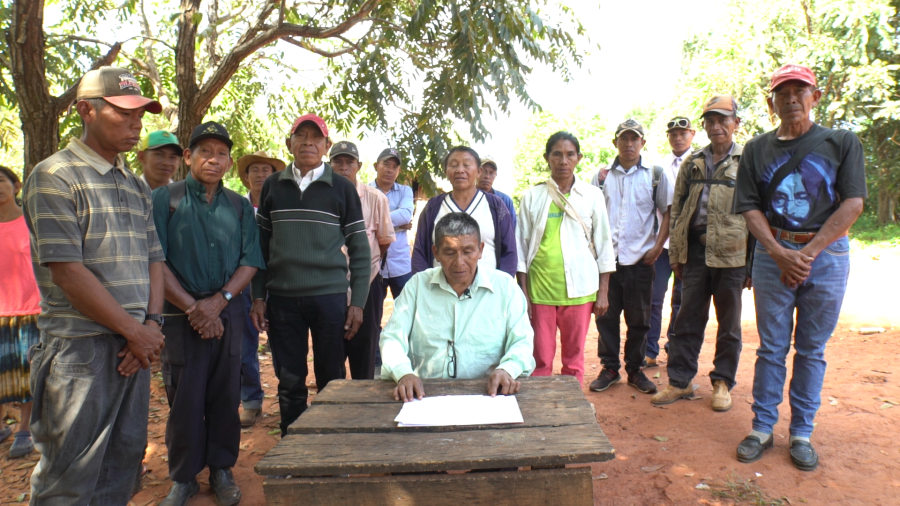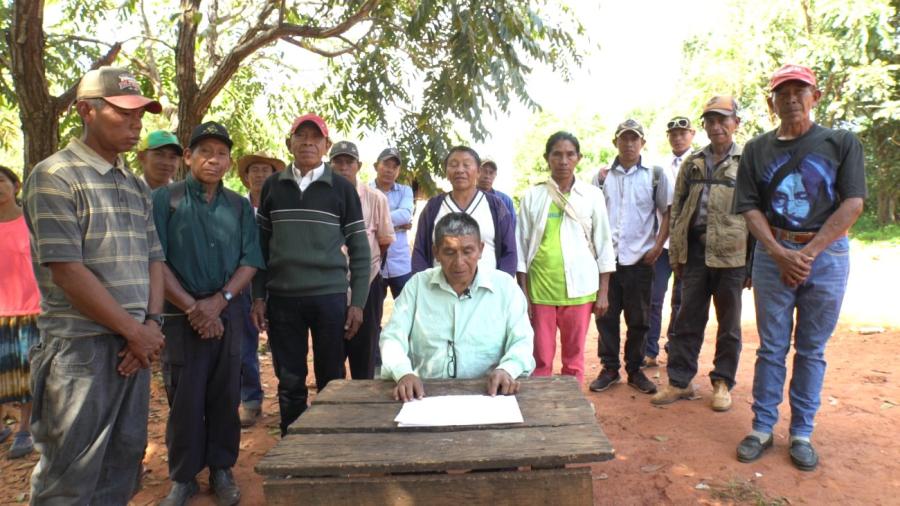

By Paola Canova
By early December of 2014, in the northern Chaco region of Paraguay, bulldozers from the Ministry of Public Works and Communications (MOPC) were scheduled to open their way through the thick forest into Cerro León, a unique geological formation at the center of the Defensores del Chaco National Park, the largest protected forested area in the country. Encompassing 780,000 hectares, the park is home to an array of ecological diversity unique to lowland South America, including numerous animal and plant species in risk of extinction. Known by the Ayoreo Indigenous peoples as Cucarani, Cerro León extends for about forty kilometers in diameter and is comprised of a succession of hills located within their ancestral territory. According to local NGO Iniciativa Amotocodie, some of the last Ayoreo in so-called voluntary isolation continue to inhabit part of this area.
The project, entitled "Geological Prospection of the Defensores del Chaco National Park," calls for extraction and analysis of rock samples with the goal of evaluating the possibility of using Cerro León as a source of stone materials for pavement. Ultimately seeking to convert part of the area into a rock quarry, this project violates national laws as well as international treaties ratified by the Paraguayan government. Its launch was scheduled not only lacking the environmental permits required by the Secretary of the Environment (SEAM), but also obviating the requisite process of consultation, which, according to Convention 169 of the International Labor Organization, is a fundamental right of Indigenous peoples affected by such undertakings in their territories.
This impending advance on Cerro León and the park where it is located only came to light following a recent newspaper investigation which appeared on December 26 in Paraguay’s most widely circulated newspaper (ABC Color). In a quick move, the Ayoreo organization Union de Nativos Ayoreo del Paraguay (UNAP) organized a two-day road blockage to protest the threat to their territory. Simultaneously, another Ayoreo organization, Asociacion Garaigosode del Paraguay (AGPA), with the support of local NGOs Tierraviva and Sobrevivencia, advanced a precautionary writ of amparo against the MOPC and SEAM opposing any exploitative activity in the park. In a positive turn for the Ayoreo, by January 14, 2015, a judge had approved the amparo.
An environmental impact report for this project, a legal prerequisite for obtaining an environmental license, was drafted by the MOPC and designates provision for specific tasks as well as a timeline. Curiously, however, there is no official date on this document. The indiscretion of the MOPC is further highlighted by the fact that, in the report, initial advancement into Cerro León is scheduled for December 1, although the SEAM only officially acknowledged receipt of the report ten days later. It is clear that the MOPC had begun, at the very least, to plan action before being granted the necessary license. During this time both institutions also sidestepped the required consultations with the Ayoreo. Moreover, they audaciously appealed the writ of amparo only a day after the Minister of SEAM visited the Ayoreo to negotiate lifting the blockage -- assuring the Ayoreo protection of their territory and their involvement in a process of consultation.The supporting lawyers for the Ayoreo responded to the appeal requesting the ratification of the writ of amparo. Despite compelling evidence of actions taken by both governmental institutions involved (which included the promulgation of a law modifying the use of the protected area for economic purposes), the Cartes administration publicly denied intentions of accessing inexpensive raw materials. Acquisition of these raw materials would eventually benefit private construction firms for roadworks in the Chaco region.
In a somber precedent for the protection of the Indigenous rights and the environment in Paraguay, on February 9, 2015, the national court of appeals revoked the amparo promoted by the Ayoreo and their lawyers which was temporarily protecting Cerro León. This is an undeniable message that the current administration will push aside the rights of Indigenous peoples, their territories and the environment if they obstruct economic development and private lucrative interests. The ongoing events at Cerro León further expose the vulnerability of the Chaco region, especially its Indigenous peoples, to a resurging wave of looting and frontier-style development which has historically characterized this region. Several additional NGOs have added their support to the Ayoreo by forming a coalition to defend Cerro León. The decision to preserve it or release it to imminent depredation now rests, ironically, in the hands of the Secretary of the Environment.
Photos:
Meeting of UNAP to discuss events at Cerro León, courtesy of UNAP.
Trip of Members of AGPA to Cerro León, courtesy of Ronald Sereda Picanerai.


